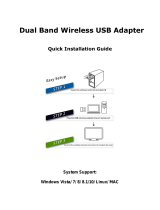
5
Deleting Folders ........................................................................................23
Folder Access Control List (ACL) .................................................................. 23
Service Folders...................................................................................24
Network Management .........................................................................25
WAN Configuration .............................................................................25
LAN Configuration...............................................................................26
DHCP Configuration ............................................................................26
WLAN Configuration............................................................................27
Web Services Configuration..................................................................28
Windows Network Configuration (SMB/CIFS) ..........................................29
Apple Network Setup ..........................................................................30
User and Group Management ..............................................................30
Local User Configuration......................................................................30
Adding Users ............................................................................................31
Modifying Users......................................................................................... 31
Deleting Users ..........................................................................................32
Local Groups Configuration ..................................................................32
Adding Groups ..........................................................................................32
Modifying Groups ......................................................................................33
Deleting Groups ........................................................................................33
System Management ...........................................................................34
System Notifications ...........................................................................34
System Logs......................................................................................35
Time and Date Settings.......................................................................35
System Configuration Backup and Restore .............................................36
Module Management...........................................................................37
Reset to Factory Default Settings..........................................................37
Upgrading System Firmware ................................................................38
Change Administrator Password............................................................38
Reboot and Shutdown System..............................................................39
Logout ..............................................................................................39
Chapter 4: Additional Feature Setup............................................ 40
Overview.............................................................................................40
FTP Server...........................................................................................40
iTunes® Server....................................................................................41
Media Server .......................................................................................42
Adding Media Share Folders .................................................................42
Connecting DMAs to the Media Server ...................................................43
Download Manager..............................................................................44
Adding an HTTP Task ..........................................................................44
Adding an FTP Task ............................................................................45
Adding a BT Task................................................................................45
Deleting Tasks ...................................................................................45
Scheduling Downloads.........................................................................46
Printer Server......................................................................................47
Windows XP SP2.................................................................................47
Windows Vista....................................................................................47
Chapter 5: Using the N1200......................................................... 51
Overview.............................................................................................51
Login Page...........................................................................................51
Web User Interface .............................................................................51
Using WebDisk ....................................................................................52
Using iTunes® Server..........................................................................53
Adding Music Files ..............................................................................53
Playing Music Files..............................................................................53





















